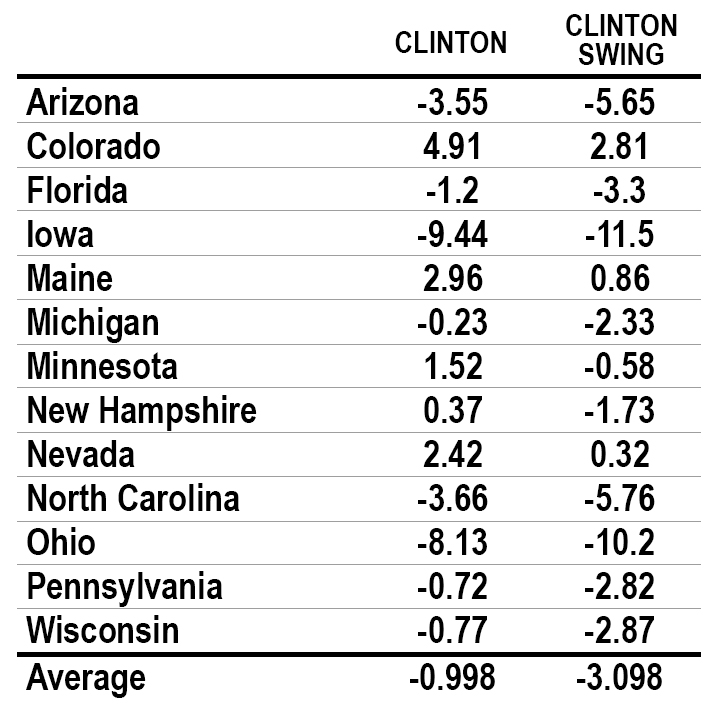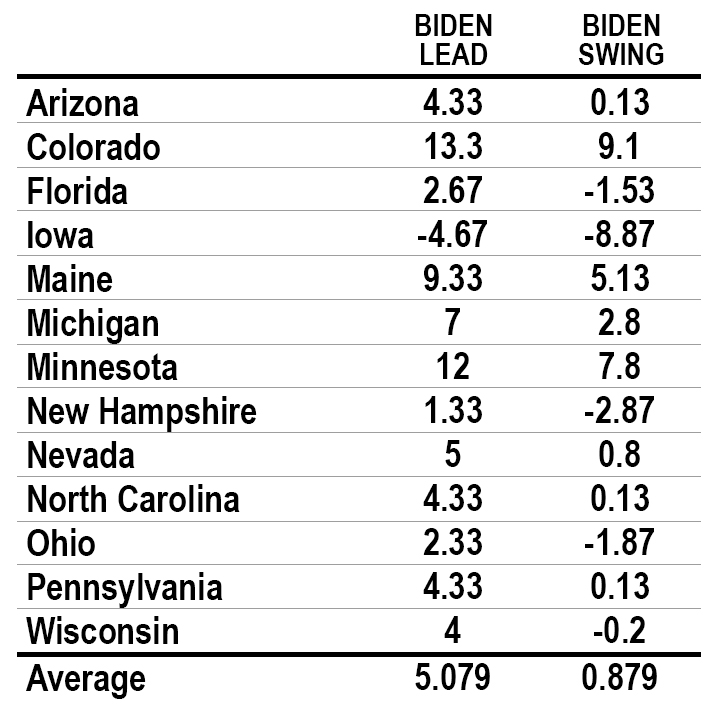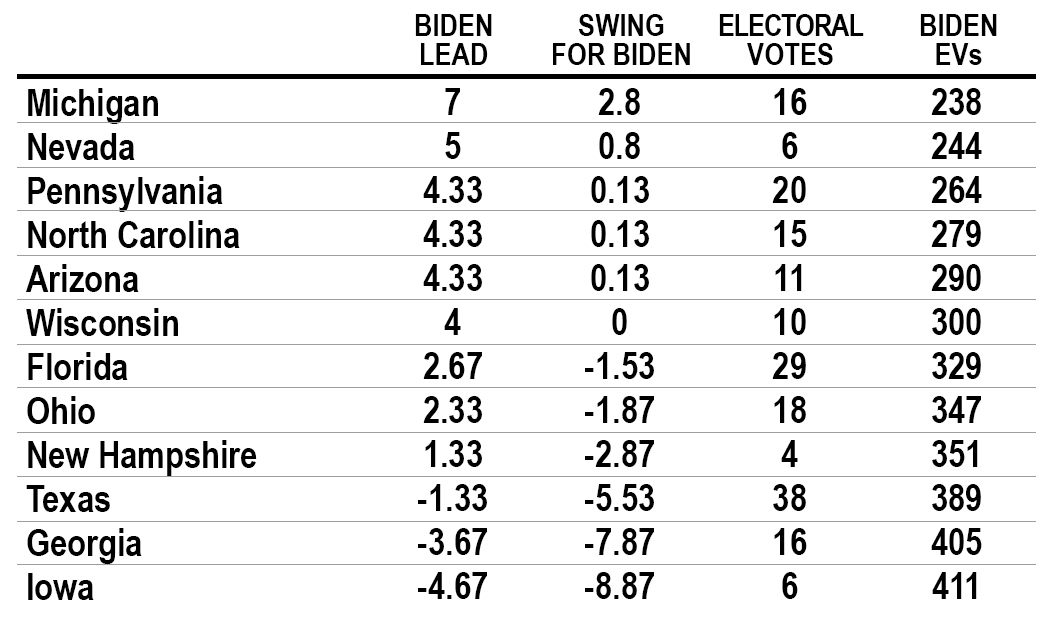How Trump lost his Electoral College edge to Biden
Not only has Trump's Electoral College fortress crumbled like one of his mismanaged businesses, but Biden might just be building one of his own


The idea that President Trump possesses an enormous Electoral College advantage in November's election has become an article of faith among thinkers across the political spectrum. Democrats have mostly thought about November's election in terms of how many more extra points of the popular vote they'll need order to actually win the election, while the president himself has for more than three years now pursued a disastrous and alienating governing strategy premised on the idea that he shouldn't even try to win a national majority. But what if Trump's Electoral College fortress has crumbled, and it is former Vice President Joe Biden whose fortunes are now enhanced by this bizarre and antiquated institution?
Some of the Democrats' renewed Electoral College freakout can be traced to New York Times analyst Nate Cohn. In July of last year, he wrote an article in which he claimed that Trump's "advantage in the Electoral College, relative to the national popular vote, may be even larger than it was in 2016." In that widely shared piece, which caused panic attacks in Democrats across the country, he argued that the Democratic candidate could win the national popular vote by as many as 5 points — more than double Hillary Clinton's margin in 2016 — while still losing the Electoral College to Trump.
Respected prognosticator Dave Wasserman of the Cook Political Report also argued that Trump could lose by five million votes — nearly double Clinton's margin — and still capture the Electoral College. A University of Texas - Austin model predicted Democrats were almost twice as likely to be victimized by an Electoral College misfire than Republicans. By the fall this idea had become conventional wisdom on the left.
The Week
Escape your echo chamber. Get the facts behind the news, plus analysis from multiple perspectives.

Sign up for The Week's Free Newsletters
From our morning news briefing to a weekly Good News Newsletter, get the best of The Week delivered directly to your inbox.
From our morning news briefing to a weekly Good News Newsletter, get the best of The Week delivered directly to your inbox.
I found these analyses to be implausible, if within the realm of possibility, at the time — they required the Democratic nominee to expand Clinton's already considerable margins in big blue states like California, New York, and Illinois; to come close to winning newly purple states like Texas, Georgia, and Arizona but to fall just short of doing so; and to lose most of the traditional swing states. There was little evidence at the time that Trump's approval ratings were heading in these directions. But subsequent events and new state polling have proven Cohn's take to be even shakier.
Let's first look at what happened in 12 battleground states in 2016. The chart below first shows Hillary Clinton's margin in each of those states, and then the total point swing against her national popular vote margin of 2.1.

But that's not what we see right now, nor has it ever been, really. Joe Biden's polling average has been consistently higher than Clinton's final margin throughout this campaign and currently stands at 4.2 points for the last five public polls listed on Five Thirty Eight. (I use Five Thirty Eight, because the most popular alternative — the Real Clear Politics average — provides no explanation of why it excludes certain surveys from its calculations, and is not yet consistently updating state averages.)On average, Clinton lost these 12 states by a point, and did more than 3 points worse in the battlegrounds than she did nationally. This map allowed Trump's fluke Electoral College victory. And there's no question that if Democrats had made up some but not enough ground in red states, expanded their blue state margins and treaded water in purple states, we'd be looking at another repeat of 2016.
How does Trump's vaunted Electoral College border wall look when we stack up the national polling against state surveys? Not so great. I took the last five national public polls on Five Thirty Eight from distinct pollsters, excluding those from pollsters with worse than a C rating, and stacked the average against the same parameters for the states, but with just the last three polls because the state polling is more sparse. The data below is current through Monday, May 11. Biden leads in those 12 states by over 5 points and is outperforming his national average by nearly a point. Whereas Clinton did worse than her national margin in 9 of the 12, Biden is doing better in 8.
A free daily email with the biggest news stories of the day – and the best features from TheWeek.com

To understand why these numbers confer an Electoral College advantage on Biden rather than Trump, we need to look at the concept of the tipping point state — the state most likely to get either candidate past the magic number of 270. In order for Biden to be at a disadvantage in the Electoral College, the state which gets him to 270 needs to be one in which his lead is less than his national polling average, so that if he were to win the popular tally by, say, 100,000 votes, he would still lose the election to President Trump. And that looks extremely unlikely given these numbers. Let's spot Biden 222 electoral votes, including Colorado, Maine, and Minnesota (and assuming Trump wins the 2nd district in Maine, which splits its Electoral Votes). After that, let's take it one state at a time according to current polling to get to 270, from his largest margin over his national average to smallest, and how many Electoral Votes he'd get by winning each state in succession.

Today's polling has Pennsylvania, North Carolina, and Arizona tied as the tipping point states. As you can see, we don't get to a swing state where Biden does worse than his national average until Florida, which in this scenario he would not need to win. And if Biden wins the national popular vote by his current average of 3.8 points, he's likely to score a 351-Electoral Vote landslide, not lose the election to Trump as many liberal pundits fear. If he expands his national margin to 6 points, he would be a good bet to win Texas. At 8 points he would add Georgia, and at 9 Iowa goes blue too.
For our purposes, the important thing to note is that current polling indicates that it is Trump who could win a tiny popular vote majority but still lose the election to Biden. To understand why, think of Trump's path as the mirror image of Biden's. If the president were to win the popular vote by, say, one-tenth of a point, he would win Iowa, Georgia, Texas, New Hampshire, Ohio, Florida, and Wisconsin but still lose Pennsylvania, North Carolina and Arizona, because in those three pivotal states he is doing slightly worse than his national polling average. Those losses would be achingly close — probably just a few thousand votes in each state. But the final Electoral College tally would be 294 for Biden and 244 for Trump.
To be sure, the six months between now and November are a very long time, especially with the politics-scrambling COVID-19 pandemic wantonly destroying lives and livelihoods. Some of the polls I scraped here are somewhat old, others are from firms with unknown reputations, and in any case, a few outlier surveys here and there could scramble these charts substantially. Right now we are just not getting synchronous state and national polls. So Democrats should take nothing for granted and it is certainly possible that President Trump and his allies will somehow manage to turn their inept response to the pandemic to their advantage, especially if they maintain their huge cash advantage. But there are reasons beyond Trump's crumbling Electoral College fortress to be optimistic about the party's chances in the fall, and doubtful of a 2016 repeat.
First, Democrats have consistently held a massive advantage on the generic congressional ballot, which asks respondents which party they intend to vote for in congressional races. Right now they hold an average lead of 8 points in the last five generic ballot polls, bigger than any edge they held during at any point in 2015 or 2016 and close to their advantage in 2018. Since 2000, the House popular vote and the presidential popular vote have not diverged by more than 3.5 points. And if Democrats win the House with a popular vote advantage of 7.7 points, you can be almost 100 percent certain that Biden will also win.
It's also worth remembering that after the 2012 election and for most of the 2016 cycle, almost everyone was convinced that it was Democrats who had the Electoral College advantage, based on little more than the party's victories in back-to-back presidential elections in 2008 and 2012. (The folks at Five Thirty Eight were a lonely voice in the wilderness about this). Remember the vaunted Blue Wall? But at least two states have flipped between parties every election since 1860. In 2016 it was six: (Ohio, Florida, Iowa, Wisconsin, Pennsylvania, Michigan). Pennsylvania and Michigan seem like longshots for Trump. If he wants another term, he'll have to hold Democratic flips to post-Civil War low of two states. Not only does Biden also lead in Wisconsin, but Arizona looks like it has undergone a rapid partisan transformation in the last four years of the sort that happened to Virginia between 2004 and 2008. There are no particularly plausible candidates to flip from blue to red this year, at least not in a world in which Biden wins the popular vote.
The Electoral College is a dreadful, indefensible institution, but it probably does not consistently favor one party over the other, at least not for more than a few elections in a row. And based on the numbers we're seeing today, not only has Trump's Electoral College fortress crumbled like one of his mismanaged businesses, but Biden might just be building one of his own.
Want more essential commentary and analysis like this delivered straight to your inbox? Sign up for The Week's "Today's best articles" newsletter here.
David Faris is a professor of political science at Roosevelt University and the author of "It's Time to Fight Dirty: How Democrats Can Build a Lasting Majority in American Politics." He's a frequent contributor to Newsweek and Slate, and his work has appeared in The Washington Post, The New Republic and The Nation, among others.
-
 Political cartoons for January 3
Political cartoons for January 3Cartoons Saturday's political cartoons include citizen journalists, self-reflective AI, and Donald Trump's transparency
-
 Into the Woods: a ‘hypnotic’ production
Into the Woods: a ‘hypnotic’ productionThe Week Recommends Jordan Fein’s revival of the much-loved Stephen Sondheim musical is ‘sharp, propulsive and often very funny’
-
 ‘Let 2026 be a year of reckoning’
‘Let 2026 be a year of reckoning’Instant Opinion Opinion, comment and editorials of the day
-
 Bari Weiss’ ‘60 Minutes’ scandal is about more than one report
Bari Weiss’ ‘60 Minutes’ scandal is about more than one reportIN THE SPOTLIGHT By blocking an approved segment on a controversial prison holding US deportees in El Salvador, the editor-in-chief of CBS News has become the main story
-
 Could Trump run for a third term?
Could Trump run for a third term?The Explainer Constitutional amendment limits US presidents to two terms, but Trump diehards claim there is a loophole
-
 Has Zohran Mamdani shown the Democrats how to win again?
Has Zohran Mamdani shown the Democrats how to win again?Today’s Big Question New York City mayoral election touted as victory for left-wing populists but moderate centrist wins elsewhere present more complex path for Democratic Party
-
 Millions turn out for anti-Trump ‘No Kings’ rallies
Millions turn out for anti-Trump ‘No Kings’ ralliesSpeed Read An estimated 7 million people participated, 2 million more than at the first ‘No Kings’ protest in June
-
 Ghislaine Maxwell: angling for a Trump pardon
Ghislaine Maxwell: angling for a Trump pardonTalking Point Convicted sex trafficker's testimony could shed new light on president's links to Jeffrey Epstein
-
 The last words and final moments of 40 presidents
The last words and final moments of 40 presidentsThe Explainer Some are eloquent quotes worthy of the holders of the highest office in the nation, and others... aren't
-
 The JFK files: the truth at last?
The JFK files: the truth at last?In The Spotlight More than 64,000 previously classified documents relating the 1963 assassination of John F. Kennedy have been released by the Trump administration
-
 'Seriously, not literally': how should the world take Donald Trump?
'Seriously, not literally': how should the world take Donald Trump?Today's big question White House rhetoric and reality look likely to become increasingly blurred
